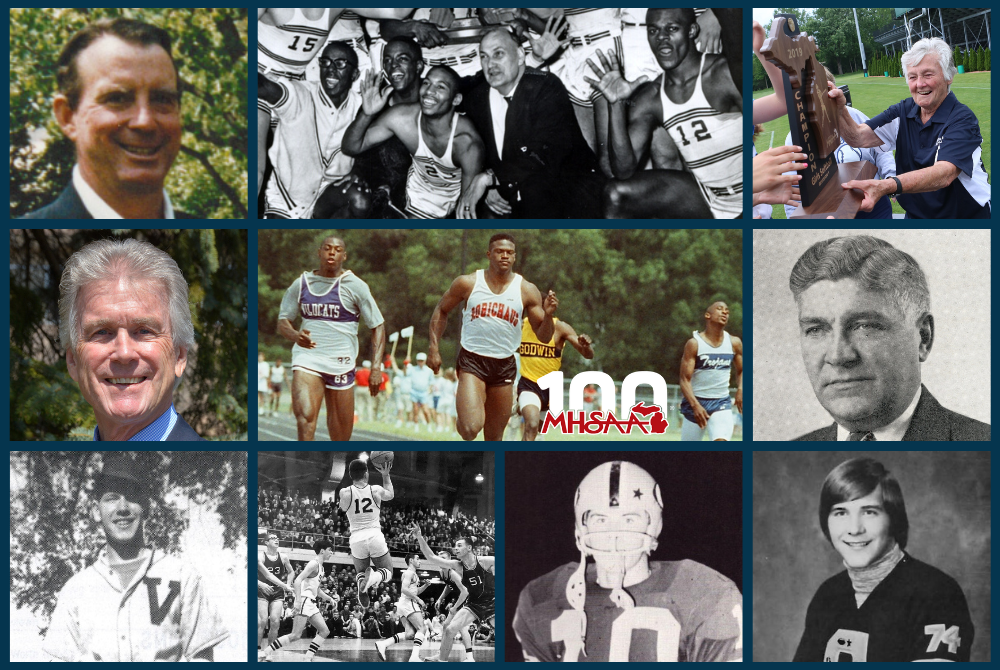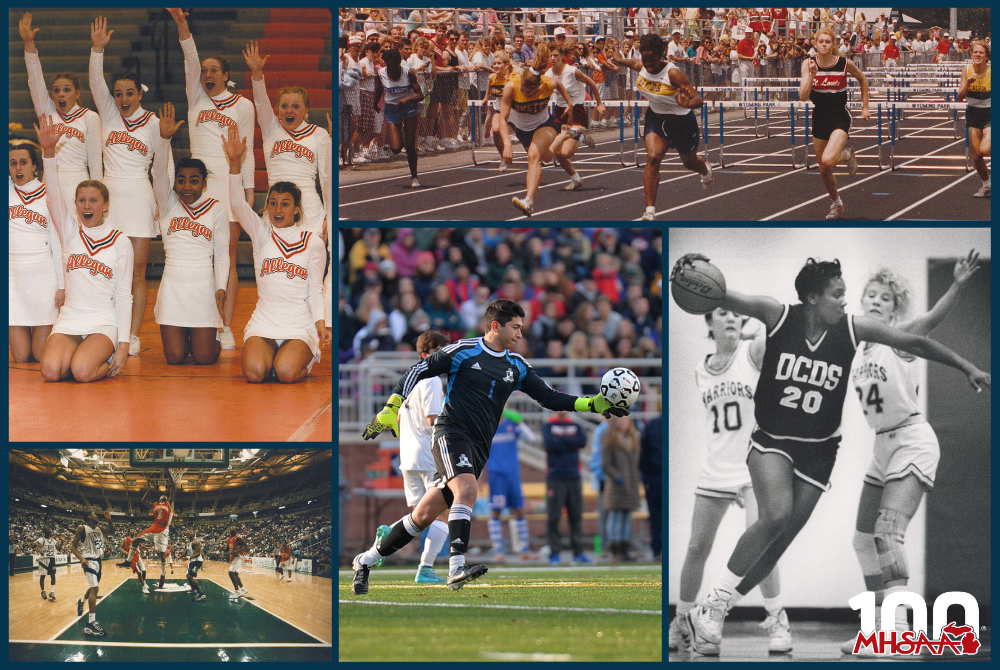
Century of School Sports: Michigan Sends 10 to National Hall of Fame
By
Geoff Kimmerly
MHSAA.com senior editor
October 1, 2024
The campaign to promote Michigan’s all-time high school greats for National High School Hall of Fame recognition is advancing full-speed ahead.
Just this summer, past Dearborn Heights Robichaud three-sport star Tyrone Wheatley became the Hall of Fame’s 10th inductee from Michigan. With his addition, Michigan’s collection still ranks only 22nd nationally in terms of number of honorees – but his selection makes three over the last nine years as the MHSAA continues to make cases for more recognition from our state’s rich history.
Michigan’s contribution to the Hall of Fame includes five athletes, three coaches and two retired MHSAA executive directors who also had colossal impacts on school sports at the national level. Wheatley joined the MHSAA’s first full-time Executive Director Charles E. Forsythe (inducted 1983), River Rouge boys basketball coach Lofton Greene (1986), Warren Regina athletic director, softball and basketball coach Diane Laffey (2000); Fennville basketball and baseball standout Richie Jordan (2001), Grosse Pointe Woods University Liggett boys and girls tennis coach Bob Wood (2005), Bloomfield Hills Cranbrook hockey standout Jim Johnson (2007), Owosso football, basketball and baseball all-stater Brad Van Pelt (2011); Vermontville Maple Valley baseball national record holder Ken Beardslee (2016) and retired MHSAA Executive Director John E. “Jack” Roberts (2022).
In addition to his selection and induction this summer, Wheatley was selected to speak on behalf of the entire 2024 Hall of Fame class during the ceremony in Boston.
The National High School Hall of Fame was started in 1982 by the NFHS. Nominations are made through NFHS member associations, including the MHSAA. Hall of Fame inductees are chosen after a two-level selection process involving a screening committee composed of active high school state association administrators, coaches and officials, and a final selection committee composed of coaches, former athletes, state association officials, media representatives and educational leaders.
Of course, not everyone nominated is eventually selected. Candidates receive a three-year period of consideration, and the MHSAA unsuccessfully campaigned for a nominee as recently as 2017-19, although multiple times that candidate reached the second level of the selection process.
Criteria also must be followed; the MHSAA (like all state associations) is limited to one athletic inductee per year, and the NFHS requires inductees to attend the annual summer ceremony unless, of course, they are deceased.
Obviously, there are several Michigan standouts absent from the list above. But as noted, the work has ramped up to bring their accomplishments to the Hall of Fame stage.
Previous "Century of School Sports" Spotlights
Sept. 25: MHSAA Record Books Filled with 1000s of Achievements - Read
Sept. 18: Why Does the MHSAA Have These Rules? - Read
Sept. 10: Special Medals, Patches to Commemorate Special Year - Read
Sept. 4: Fall to Finish with 50th Football Championships - Read
Aug. 28: Let the Celebration Begin - Read
PHOTOS Clockwise from top left: Bob Wood, Lofton Greene (in suit) with his 1965 team, Diane Laffey, Charles E. Forsythe, Jim Johnson, Brad Van Pelt, Richie Jordan (shooting the basketball), Ken Beardslee, and Jack Roberts, surrounding Tyrone Wheatley (Robichaud) during a race. (MHSAA archives.)

Century of School Sports: Everything We Do Begins with Participation
By
Geoff Kimmerly
MHSAA.com senior editor
March 5, 2025
For 100 years the MHSAA and its member schools have trumpeted the many benefits of educational athletics. The list of positive reasons to play has only grown.
But every idea and effort to make school sports excellent starts with one underlying theme that has served as a primary motivation from the beginning:
Participation.
The MHSAA long has been driven by a desire to see as many students participate in sports as possible, within a framework of rules that intentionally makes that opportunity so valuable that playing for the school team becomes the dream for thousands of kids all over our state.
And MHSAA member schools have a long history of succeeding at that mission.
A few comparisons and a decent share of context are necessary to explain how. We will dive into some numbers, but these two points sum up the story:
The total number of high school students in Michigan has been shrinking annually over several years – high-school aged population in this state is down 21 percent since 2006-07. But the numbers of students playing sports at MHSAA schools has grown three straight years and has declined by only 13.5 percent over the same stretch of time.
Michigan participation in high school sports annually outpaces where it ranked nationally in high school-aged population. We may have fewer students than some states, but more of them are playing more sports for their schools.
How do we know all this?
Every spring since 1971, the MHSAA has reported how many athletes from member schools participate – by sport – as part of a survey from the National Federation of State High School Associations (NFHS). Those numbers are crunched by the NFHS for all 50 states and Washington, D.C., and over the last several years the MHSAA has taken that data and then compared how Michigan participation stacks up to state populations of people aged 14-17.
(The NFHS collects data on all school sports, whether they receive state association sponsorship or not. Participants also are counted once for every sport they participate in, so two-sport athletes are counted twice, three-sport athletes are counted three times, etc.).
For this narrative’s sake, let’s start with the 1977-78 school. By then, several girls sports had begun to receive MHSAA sponsorship and also had a few years to get established and grow. For that school year, the MHSAA reported 242,616 participants. Just under a decade later, for 1985-86, that total had grown to 265,227 (and a few more girls sports had been added), and those totals continued to rise during the 1990s reaching 295,858 in 2000-01.
A key high point came in 2006-07, when the MHSAA reported 320,479 total participants in all sports at member schools including 313,093 in MHSAA-sponsored sports. The grand totals then shifted downward slowly once again – but in proportion to falling student enrollment at MHSAA member schools, which has dropped nearly 113,000 students (21 percent) since that notable year. It’s also fair to make an educated guess – because students are counted once for every sport played – that a trend toward sport specialization also affected those numbers to some degree.
Fast forward to today. For the 2023-24 school year, there were 270,664 participants in MHSAA sports, plus another 19,920 in sports not sponsored by the association (weight lifting, etc.). So while Michigan hasn’t approached 300,000 participants in more than a decade, the total for MHSAA sports this past year was only 13.5 percent fewer than that 2006-07 season – again, compared to 21-percent fewer students at those schools. And the even better news? Participation has increased three straight years coming out of the COVID-19 pandemic.
Another telling comparison is how Michigan participation continues to compare nationally.
Going back to at least the 2012-13 school year – not counting 2019-20 and 2020-21, when the NFHS survey was suspended because of COVID-19’s effect on school sports – Michigan consistently has ranked either seventh or eighth in participation nationally, falling past that ranking only once to ninth. For 2023-24, Michigan ranked eighth for participation.
Meanwhile, Michigan ranked ninth nationally for high school-aged population from 2012-13 through 2015-16 before sliding into its current 10th spot on that list. So for this past school year, participation at MHSAA member schools ranked two spots ahead of its ranking for high school-aged population.
The first step to receiving the benefits of school sports is getting out there and playing them. And Michigan high schoolers are continuing to do so – both at rates that compare well historically over the last 50 years, and compared to states across the country of similar sizes. This has long been a point of MHSAA pride, and will continue to be a primary focus of its work.
Previous "Century of School Sports" Spotlights
Feb. 25: Slogans & Logos Remain Unforgettable Parts of MHSAA History - Read
Feb. 19: MHSAA Tickets Continue to Provide Fan-Friendly Value - Read
Feb. 11: We Recognize Those Who Make Our Games Go - Read
Feb. 4: WISL Conference Continues to Inspire Aspiring Leaders - Read
Jan. 28: Michigan's National Impact Begins at NFHS' Start - Read
Jan. 21: Awards Celebrate Well-Rounded Educational Experience - Read
Jan. 14: Predecessors Laid Foundation for MHSAA's Formation - Read
Jan. 9: MHSAA Blazes Trail Into Cyberspace - Read
Dec. 31: State's Storytellers Share Winter Memories - Read
Dec. 17: MHSAA Over Time - Read
Dec. 10: On This Day, December 13, We Will Celebrate - Read
Dec. 3: MHSAA Work Guided by Representative Council - Read
Nov. 26: Finals Provide Future Pros Early Ford Field Glory - Read
Nov. 19: Connection at Heart of Coaches Advancement Program - Read
Nov. 12: Good Sports are Winners Then, Now & Always - Read
Nov. 5: MHSAA's Home Sweet Home - Read
Oct. 29: MHSAA Summits Draw Thousands to Promote Sportsmanship - Read
Oct. 23: Cross Country Finals Among MHSAA's Longest Running - Read
Oct. 15: State's Storytellers Share Fall Memories - Read
Oct. 8: Guided by 4 S's of Educational Athletics - Read
Oct. 1: Michigan Sends 10 to National Hall of Fame - Read
Sept. 25: MHSAA Record Books Filled with 1000s of Achievements - Read
Sept. 18: Why Does the MHSAA Have These Rules? - Read
Sept. 10: Special Medals, Patches to Commemorate Special Year - Read
Sept. 4: Fall to Finish with 50th Football Championships - Read
Aug. 28: Let the Celebration Begin - Read

